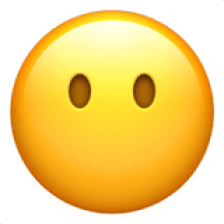Dictionary.com Starts Defining Emoji
Dictionary.com has added emoji definitions to its site, and I have an interview with the lexicographer behind the decision, Jane Solomon. Emoji are a lot more linguistically complex than you may imagine.
Dictionary.com has started defining emoji. What follows is a lightly edited transcript of my interview with Jane Solomon, lexicographer at Dictionary.com.
Solomon: One thing as lexicographers that we think about when we’re adding words or information about items like this to to dictionary is do people actually want to look it up? It takes a lot of work and effort and research to write one definition or any kind of content of this kind of. We do lexical research, so if we’re going put in the work, we want to make sure it is something that people are interested in. We saw that there was a gap in resources in terms of getting specific linguistic information about emoji, so it made a lot of sense to us to to add some of this information to Dictionary.com.
Fogarty: Were you getting questions from people or were you finding that people were already trying to search for emoji on Dictionary.com?
Solomon: We were finding that generally people were trying to search for emoji both on Dictionary.com and elsewhere, so we thought, “OK, let’s test this out!”
We don’t have a ton of emoji. We certainly don’t define every single emoji that exists. It’s more of an experiment. We’re starting with some emoji that have some interesting, maybe not-so-obvious meanings, and we want to see whether people are actually going to be using Dictionary.com as a resource for this kind of material.
Fogarty: How did you choose the emoji that you decided to include?
Solomon: It was based on some information we had gathered on search engine optimization (SEO) and also based on my own personal interest in certain emoji. I am
a member of the Unicode Emoji Subcommittee, and I have come across a lot of really interesting emoji that when I learn what they actually are being used for and what the meanings actually have grown to be, it’s really interesting, and I thought those would be good places to start.
Fogarty: As a lexicographer, how do you even research what an emoji means? I mean, when you research words, I know you look at them in context and and all that, but it seems as if it would be harder for an emoji.
Solomon: Well, you you start with the same kind of research. You’re looking at how people are using emoji in context. For example, when I first learned the context for the goat emoji I was really excited. The initialism GOAT stands for “greatest of all time,” and when I learned that, I wondered are people using the goat emoji in this way? And they actually were. You’ll often see it used with a celebrity or maybe a musician or an athlete. I’ve seen it used with Barack Obama. So I had this hunch: I wonder if people are actually using it in this way? And then they were.
Fogarty: So if you see Beyoncé and the goat emoji, it’s not someone calling her a goat; it’s someone saying she’s the greatest of all time.
Solomon: Yes, and often times people will use the goat emoji in addition to having the letters G-O-A-T spelled out, usually capitalized, sometimes with periods in between, so that can give you a hint at meaning. The emoji you often see Beyonce coupled with the bee because her fans call her Bae, and the fans are actually called the “bae hive.” That sounds like “bee,” so you get the bee emoji, and you also see her with the lemon emoji because of her her album “Lemonade.”
Fogarty: So how do people find emoji on your site?
Solomon: Well, right now the emoji on our site live in our editorial home. It is not in the same place as the straight-up traditional dictionary definitions. These are more like supplemental articles. They give you a lot of information and a lot of context; it’s not just a one sentence definition because we felt that with emoji we wanted to give a little bit more information than we’d give when we define a word.
Fogarty: Right, and they seem a little bit more like slang to me, so I imagine…words, obviously change their meaning over time, but I imagine that emoji may change their meaning even faster. Is that something that you’ve already seen or that you’re worried about in the future for keeping up with it?
Solomon: So you said that emoji seem like slang to you, and I think you’re definitely on to something there. Emoji are used in a more casual register than some more formal words in English, so yeah, their meanings are in flux, and this means that we are keeping an eye on it. Meanings change all the time, and that can be based on things like individuals who have a wide following who start using emoji a certain way and then, a lot of people start using emoji in that same way. Whenever the Unicode Consortium releases new emoji, that can change how they are being used. Whenever platforms redesign existing emoji, that can change how people are using the emoji. An example of this is the gun emoji: when Apple changed their design from something that looked more like a realistic gun to a squirt gun, that could very well have an impact on how people view this emoji and how people as a result use the emoji.
I view this is a bold statement, but I believe any really successful emoji dictionary would have to be as a sort of historical dictionary. You have to understand what an emoji looks like over time, other emoji that have existed that could have similar meanings, and when those emoji came out. So for example, you have the face with tears of joy emoji. This is by far the most popular emoji. It could be because of its placement on the emoji keyboards, but it’s also a very useful emoji that can mean a lot of different things. It can evoke sarcasm or joy, and those are two really universal moods. But because this Emoji so popular, there been other emojis that have gotten through the Unicode Emoji Subcommittee review that also express sarcasm and are really effective in that. An example of this is the upside down smiley face or maybe the face with no mouth face.
Fogarty: What does it mean [the face with no mouth]?
Solomon: That one can be used as a response when you are speechless.
Fogarty: Oh, that makes sense—no mouth.
Solomon: Or when you want to respond in a rude way. It can almost have a similar meaning to the face with a straight line as the mouth. Like you’re just staring wide eyed,
but your mouth is completely closed. People use that emoji in any kind of situation where you would have that facial expression.
Fogarty: I noticed that we both use “emoji” as the plural, but some people use “emojis.” Do you have a stance?
Solomon: They both are completely fine. This is my personal preference, but I sometimes switch between them, so don’t hold me to it.
Fogarty: OK, and to finish up can you tell me about some more emoji whose meanings might surprise me or that people may not know but that are included in your set?
Solomon: Are you familiar with the the emoji that’s like painting nails?
Fogarty: Yes, it feels dishy to me—sort of like you just heard some bad gossip or some juicy gossip.
Solomon: Yes, it’s definitely used that way. It’s also used more literally, like, I’m painting my nails or I’m putting on makeup or getting my hair done—like that kind of more literal meaning—but yeah, it’s used in this very sassy way. It’s used sometimes to throw shade or to show disrespect toward someone in a sort of sassy way.
Fogarty: How about one or two more.
Solomon: The fire emoji is pretty interesting. That one can be used really literally as actual fire, but it can also be used…have you heard the the expression “lit”?
Fogarty: Yes. It can be used like “This party is lit,” right?
Solomon: Exactly people are using it in that exact context. They might replace the word “fire,” and you can also say, “This party is fire.” (And I say “you” in general. I actually have never said that.)
With the fire emoji, sometimes people will be talking about something and use the word “fire” or “lit” and then have the fire emoji appear next to it—next to those words. So sometimes it replaces the word, and sometimes it sits beside it as supplemental information.
You can find Jane Solomon on Twitter and on her blog, Lexical Items.
The second half of this interview is only available in the podcast audio: Apple Podcasts, Stitcher, Spotify.










